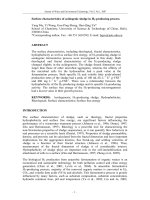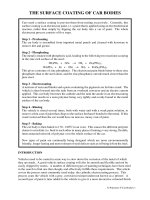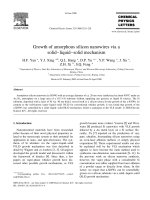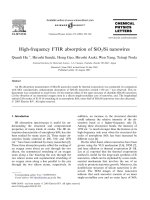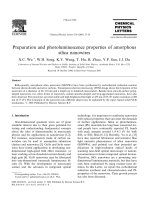- Trang chủ >>
- Khoa Học Tự Nhiên >>
- Vật lý
Surface structure of cubic diamond nanowires
Bạn đang xem bản rút gọn của tài liệu. Xem và tải ngay bản đầy đủ của tài liệu tại đây (437.93 KB, 7 trang )
Surface structure of cubic diamond nanowires
A.S. Barnard, S.P. Russo
*
, I.K. Snook
Department of Applied Physics, Royal Melbourne Institute of Technology, GPO Box 2476V, Melbourne, VIC 3001, Australia
Received 20 November 2002; accepted for publication 9 May 2003
Abstract
Presented are results of our ab initio study of the surface reconstruction and relaxation of (1 0 0) surfaces on dia-
mond nanowires. We have used a density function theory within the generalized-gradient approximation using the
Vienna ab initio simulation package, to consider dehydrogenated and hydrogenated surfaces. Edges of nanowires offer
a new challenge in the determination of surface structure. We have applied the methodology for stepped diamond (1 0 0)
surfaces to this problem, and consider it useful in describing diamond nanowire edges to first approximation. We have
found that dimer lengths and atomic layer depths of the C(1 0 0)(2 · 1) and C(1 0 0)(2 · 1):H nanowire surfaces differ
slightly from those of bulk diamond and nanodiamond surfaces. The aim of this study is provide a better understanding
of the effects of nano-scale surfaces on the stability of diamond nanostructures.
Ó 2003 Elsevier B.V. All rights reserved.
Keywords: Density functional calculations; Surface relaxation and reconstruction; Diamond
1. Introduction
The emerging field of molecular nanotechnol-
ogy has introduced a wide range potential appli-
cations of nanostructured materials, for a variety
of purposes. One-dimensional (1-D) nanowires
have been proposed as important components,
playing an integral part in the design and con-
struction of both electronic and optoelectronic
nanodevices [1]. Significant work has been com-
piled regarding the structure and properties of
semiconductor nanowires including silicon [2,3],
silicon carbide [4,5] and carbon [6]. The growth of
carbon nanowires has been achieved using a
number of techniques including laser-induced
chemical vapor deposition [7], high pressure
treatment of catalyst containing thin films [8],
annealing of silicon carbide films [9] and annealing
of pressed graphite containing tablets [10]. Aligned
diamond nanowhiskers (a term used to describe
particular nanowires) have been formed using air
plasma etching of polycrystalline diamond films
[11]. Dry etching of the diamond films with mo-
lybdenum deposits created well-aligned uniformly
dispersed nanowhiskers up to 60 nm in diameter
with a population density of 50/lm
2
. These dia-
mond nanowhiskers showed well-defined charac-
teristics of diamond [12].
Diamond (carbon) based materials have been
suggested to be the optimal choice for nano-
mechanical designs, due to their high elastic
modulus and strength-to-weight ratio [13,14]. This
has prompted a number of theoretical studies in-
vestigating various aspect of diamond at the nano-
*
Corresponding author. Tel.: +61-3-9925-2601; fax: +61-3-
9925-5290.
E-mail address: (S.P. Russo).
0039-6028/03/$ - see front matter Ó 2003 Elsevier B.V. All rights reserved.
doi:10.1016/S0039-6028(03)00733-7
Surface Science 538 (2003) 204–210
www.elsevier.com/locate/susc
scale. An important aspect of simulating nanodi-
amond structures is to correctly model their
surfaces. Clean [15–20] and hydrogen passivated
[16–28] C(1 0 0) bulk diamond surfaces have been
the topic of many investigations using a variety of
experimental and theoretical methods. More re-
cently the (1 0 0) surfaces of diamond nanocrystals
have been examined [29,30]. To assist in providing
a better understanding of the surfaces of diamond
nanostructures we are interested in extending these
research efforts to include diamond nanowires.
Presented here is a density functional theory
(DFT) study of the surface structure of selected
diamond nanowires using the Vienna ab initio
simulation package (VASP) [31,32]. We used ultra
soft, gradient corrected Vanderbilt type pseudo-
potentials [33] as supplied by Kresse and Hafner
[34], and the valence orbitals are expanded on a
plane-wave basis up to a kinetic energy cutoff of
290.00 eV. All calculations were performed in the
framework of DFT within the generalized-gradi-
ent approximation (GGA), with the exchange-
correlation functional of Perdew and Wang [35].
This method has been successfully applied to bulk
diamond [36] and nanodiamond [37], and has been
shown to give results in excellent agreement with
experiment and all electron methods [26].
The surface structure has been analysed for two
dehydrogenated and two hydrogenated diamond
nanowires with cubic morphology. To ensure that
the structures are close to equilibrium, both the
ions and super-cell volume were structurally re-
laxed. Both the symmetry and the lattice parame-
ter of the nanowires were free to vary, resulting in
expansions or contractions of the entire structures.
The relaxations were performed for a minimum of
20 ionic steps (involving changes in the atomic
positions), each initially consisting of approxi-
mately 50–60 electronic steps (involving changes in
the electronic charge density surrounding the at-
oms) and converging to a minimum of 3 electronic
steps during the final ionic steps.
2. Diamond nanowires
Four infinite diamond nanowires were included
in this study, consisting of dehydrogenated and
monohydrogenated versions of two cubic struc-
tures. The structures are periodic along a [1 1 0]
direction, with two C(1 0 0)(1 · 1) surfaces and two
C(1 1 0)(1 · 1) surfaces along the length of the
nanowire. The length of the simulation cell was
1.5 nm, creating (periodic) nanowire segments
with two distinct rectangular cross-sections. The
smaller segment has an average lateral diameter of
0.6 nm and contains 132 carbon atoms in the
simulation length, while the larger segment has an
average lateral diameter of 0.85 nm and contains
240 carbon atoms in the simulation length. The
hydrogenated segments consisted of C
132
H
72
and
C
240
H
96
respectively. While the cross-section con-
sidered here represents only a simple case (that
may not be currently realistic), it has been chosen
as it facilitates the consideration of edges as well as
generous surface facets. The finite size of nano-
structures, such as nanodiamond and diamond
nanowires, lead to Ôfull structureÕ relaxation that
effect the surface as well as the bulk-like core of
these systems [29]. It is considered important to
begin to understand the variations in the structure
of diamond nanowires effected by various finite
size effects (beginning with a simple case), because
at the nanoscale the surface structure plays a sig-
nificant role in the electronic properties of the
nanowire as a whole.
In all cases the initial step of the relaxation in-
volved the reconstruction of the C(1 0 0) surfaces
to form the (2 · 1) surface structure. As the C(1 1 0)
surface does not reconstruct [38], the reconstruc-
tion is limited to the C(1 0 0) surfaces under con-
sideration. The initial and final (relaxed) structures
of the smaller dehydrogenated nanowire are
shown in Fig. 1, and final monohydrogenated
version in Fig. 2. Figs. 3 and 4 show the dehy-
drogenated and monohydrogenated results for the
larger nanowire, respectively. Each nanowire is
shown from the [1 0 0] direction (left), [1 1 0] di-
rection (centre), with the periodic boundaries to
the left and right of each image; and along the axis
of the nanowire (right).
In the case of the larger nanowires, the char-
acterization of the C(1 0 0)(2 · 1) surfaces was
achieved by considering the difference in the pri-
mary d
11
and secondary d
12
dimer lengths, and the
first Z
12
and second Z
23
layer depths. A diagram
A.S. Barnard et al. / Surface Science 538 (2003) 204–210 205
outlining this nomenclature is given in Fig. 5.
Examination of the structures shown in Figs. 1–4
reveals that there are two distinct (1 0 0) surfaces,
with dimer rows running parallel and perpendic-
Fig. 1. Initial (top) and final relaxed (bottom) dehydrogenated diamond nanowire with simulation cells containing 132 carbon atoms,
viewed form the [1 0 0] direction (left), [1 1 0] direction (centre), and along the nanowire axis (right).
Fig. 2. Final relaxed monohydrogenated diamond nanowire with simulation cells containing 132 carbon atoms, viewed form the [1 0 0]
direction (left), [1 1 0] direction (centre), and along the nanowire axis (right).
Fig. 3. Initial (top) and final relaxed (bottom) dehydrogenated diamond nanowire with simulation cells containing 240 carbon atoms,
viewed form the [1 0 0] direction (left), [1 1 0] direction (centre), and along the nanowire axis (right).
206 A.S. Barnard et al. / Surface Science 538 (2003) 204–210
ular to the nanowire axis. These have been denoted
C(1 0 0)? and C(1 0 0)k respectively, and are
shown explicitly in Fig. 6. The surface properties
of each of these surface types has been determined
for dimers positioned at the nanowire edges, and
dimer positions in the centre of the nanowire
(1 0 0) facets.
Inspection of Table 1 reveals that the dehy-
drogenated surface reconstruction and relaxation
varies depending upon the region of the nanowire
face in both the C(1 0 0)k and C(1 0 0)? cases. The
primary d
11
dimer length is reasonably sensitive to
region of the surface, and the d
12
dimer length is
consistently shorter at the edges than the centre of
the facets (although this is more pronounced for
the C(1 0 0)? surface). The Z
12
depth is also
smaller for dimers situated at the nanowire edges,
than those at centre. The Z
23
depth is significantly
reduced at the edge of the C(1 0 0)? face being
only 0.67
AA, closer to a Z
12
depth than the bulk
diamond layer separation of 0.89
AA. Overall the
C(1 0 0)k surface with dimer rows parallel to the
nanowire axis shows little variation over the sur-
face, although a slightly concave surface has re-
sulted (indicated by the difference in the Z
12
depth
for the edges and surface centre). This concave
relaxation is evident when viewing the nanowire
along the axis, as in the lower right image of Fig. 3.
Saturation of the nanodiamond surfaces with
hydrogen produces structures of lower energy that
is entirely due to the passivation of surface bonds.
However, aside from this, Table 1 shows that
monohydrogenation of the nanowire surfaces has
an important effect on the surface structure. The
addition of the hydrogens removes much of the
variation in surface structure over the (1 0 0) faces.
The d
11
and d
12
dimer lengths and the Z
12
and Z
23
Fig. 5. Diagram defining the surface structure nomenclature
used in this study. The primary d
11
and secondary d
12
dimer
lengths, and the first Z
12
and second Z
23
layer depths are shown.
Fig. 6. Diagram defining the surface types used in this study.
The orientation of the (2 · 1) dimers for the C(1 0 0)? surface
(top) and C(1 0 0)k surface (bottom) are shown. The nanowire
axis is indicated by dotted line through the centre.
Fig. 4. Final relaxed monohydrogenated diamond nanowire with simulation cells containing 240 carbon atoms, viewed form the [1 0 0]
direction (left), [1 1 0] direction (centre), and along the nanowire axis (right).
A.S. Barnard et al. / Surface Science 538 (2003) 204–210 207
layer depths are similar but not identical for the
edges and centres of the C(1 0 0) faces (see Table 1).
In addition to the surface reconstruction and
relaxation, the nanowires were also found to un-
dergo full-crystal relaxations. Both the average
lateral diameter and the simulation length was
found to contract, although this effect was signif-
icantly reduced by surface hydrogenation. These
relaxations contribute to the relaxations of the
surfaces, and have an impact on the final surface
structure. No bucking or twisting of the surface
dimers could be discerned due to the Ôedge effectsÕ.
3. Discussion: comparison with bulk and nanodia-
mond
Ignoring for a moment the variations in surface
structure over the (1 0 0) facets, the average pri-
mary and secondary dimer lengths and average
first and second layer depths (for the dehydroge-
nated and monohydrogenated cases) have been
compared with bulk diamond and nanodiamond
(see Table 2).
The results of the dehydrogenated surfaces
show that the average d
11
and d
12
dimer lengths
and the Z
12
and Z
23
layer depths for diamond
nanowires falls between those of nanodia-
mond crystals and bulk diamond surfaces. For the
monohydrogenated surfaces, the average d
11
and
d
12
dimer lengths and the Z
12
and Z
23
layer depths
for diamond nanowires are larger than those of
both bulk and nanodiamond. This surprising re-
sult is most significant in the case of the d
11
dimer
length and Z
23
layer depth, both of which are
0.05
AA larger that those of bulk diamond.
However, as shown above, edges of the nano-
wires cannot be ignored. Using the nomenclature
Table 2
Comparison of average nanowire C(1 0 0) surface properties with bulk and nanodiamond
Bulk diamond Diamond nanocrystals Diamond nanowires
C(1 0 0)
d
11
(
AA) 1.385 ± 0.003 1.44 ± 0.06 1.405 ± 0.002
d
12
(
AA) 1.517 ± 0.006 1.49 ± 0.08 1.50 ± 0.02
Z
12
(
AA) 0.68 ± 0.08 0.59 ± 0.07 0.66 ± 0.02
Z
23
(
AA) 0.91 ± 0.08 0.80 ± 0.12 0.90 ± 0.15
C(1 0 0):H
d
11
(
AA) 1.632 ± 0.008 1.63 ± 0.02 1.681 ± 0.008
d
12
(
AA) 1.545 ± 0.005 1.54 ± 0.04 1.55 ± 0.01
Z
12
(
AA) 0.81 ± 0.06 0.82 ± 0.04 0.86 ± 0.02
Z
23
(
AA) 0.91 ± 0.09 0.83 ± 0.07 0.92 ± 0.07
The nanowire results are averaged over the ÔedgeÕ and ÔcentreÕ regions.
Table 1
Averages of the relaxation and reconstruction properties of the 240 carbon atom cubic nanowire for the (1 0 0) faces, comparing the
differences in average reconstruction and relaxation for edges and surfaces
C(1 0 0)k centre C(1 0 0)k edge C(1 0 0)? centre C(1 0 0)? edge
C(1 0 0)
d
11
(
AA) – 1.384 ± 0.002 1.371 ± 0.002 1.460 ± 0.005
d
12
(
AA) 1.51 ± 0.02 1.493 ± 0.004 1.53 ± 0.01 1.455 ± 0.002
Z
12
(
AA) 0.71 ± 0.01 0.62 ± 0.01 0.69 ± 0.02 0.615 ± 0.004
Z
23
(
AA) 1.05 ± 0.02 1.00 ± 0.05 0.90 ± 0.15 0.67 ± 0.04
C(1 0 0):H
d
11
(
AA) – 1.701 ± 0.003 1.685 ± 0.008 1.657 ± 0.007
d
12
(
AA) 1.55 ± 0.01 1.548 ± 0.007 1.55 ± 0.01 1.558 ± 0.003
Z
12
(
AA) 0.854 ± 0.002 0.827 ± 0.003 0.88 ± 0.02 0.880 ± 0.002
Z
23
(
AA) 0.94 ± 0.07 0.945 ± 0.003 0.93 ± 0.05 0.85 ± 0.02
208 A.S. Barnard et al. / Surface Science 538 (2003) 204–210
of Chadi [39] single-atom steps on diamond (1 0 0)
surfaces are denoted as S
A
and S
B
when the direc-
tion of the upper terrace (2 · 1) dimers are oriented
perpendicular to the step edge and parallel to the
step edge respectively. Further, S
B
type steps may
be denoted as S
B
ðnÞ for the non-bonded type, where
there are no re-bonded atoms on the lower terrace;
and S
B
ðbÞ for the bonded type which does have re-
bonded atoms on the lower terrace. Therefore, if
we consider the edges of the nanowires as exag-
gerated steps, then the structure of the edges of the
C(1 0 0)k represent S
A
steps, and the edges of the
C(1 0 0)? represent S
B
ðnÞ steps. Under this as-
sumption, the d
11
dimer lengths for these step types
(given in Table 1), may be compared with the re-
sults for stepped bulk diamond (1 0 0) surfaces.
Calculations by Alfonso et al. [40] using DFT
LDA molecular dynamics determined that for the
dehydrogenated surface the symmetric, unbuckled
sp
2
hybridized S
A
step had a d
11
dimer length of 1.37
AA. Similarly, the symmetric sp
2
hybridized S
B
step
had upper terrace d
11
dimer lengths of 1.48
AA. In
the case of the monohydrogenated stepped surface,
the S
A
step had a d
11
dimer length of 1.61
AA.
Although the dehydrogenated surfaces com-
pared reasonably well with the corresponding
stepped diamond surfaces, the monohydrogenated
nanowire surfaces did not. The C(1 0 0)k d
11
length
for the dehydrogenated diamond nanowire edge
was found to be 0.014
AA greater than the S
A
step on
a bulk surface. However, the C(1 0 0)? surface with
dimers rows perpendicular to the nanowire axis
shows more significant differences between the
nanowire edges and facet centres. The d
11
length at
the edge was found to be 0.02
AA less than the S
B
ðnÞ
step on a bulk surface. In the monohydrogenated
case, the d
11
dimer length of 1.701
AA for the nano-
wire C(1 0 0)k edge is 0.091
AA greater than 1.61
AA
for the S
A
bulk diamond step [40]. It is also 0.081
AA
greater than S
A
step results of 1.62
AA determined
using the hybrid Density Functional (LDA) Tight-
Binding (DF-TB) molecular dynamics study by
Skokov et al. [24]. In contrast, the calculated d
11
dimer length of 1.657
AA for the monohydrogenated
nanowire C(1 0 0)? edge is only 0.027
AA greater
than 1.63
AA for S
B
type steps [24].
In summary, the dehydrogenated C(1 0 0)k d
11
length is closer to the bulk diamond S
A
step, whereas
the monohydrogenated C(1 0 0)? d
11
length is closer
to the bulk diamond S
B
ðnÞ step. This suggests that
to improve surface homogeneity dehydrogenated
diamond nanowires should be constructed with
C(1 0 0)(2 · 1) dimer rows parallel to the nanowire
axis, but monohydrogenated nanowires with dimer
rows perpendicular to the nanowire axis.
4. Conclusion
The results outlined here show that although a
considerably degree of localized variation in sur-
face structure exists due to the nanowire edges,
hydrogenation of diamond nanowire C(1 0 0) sur-
faces reduces these variations. Averaging over the
variations, the structure of dehydrogenated cubic
surfaces on diamond nanowires are characterized
by features in between bulk and nanodiamond
cubic surfaces. In contrast however, the feature of
monohydrogenated cubic nanowire surfaces do not
fall between bulk and nanodiamond. All of the
considered features, including dimer lengths and
atomic layer depths, exceeding those of bulk and
nanodiamond. This highlights that Ôfull structureÕ
relaxations are significant, and must be taken into
consideration when studying the structure of sur-
faces at the nanoscale. Simply scaling the surface
properties, or making assumptions regarding sur-
face structure that do not include finite size effects
is inappropriate.
By comparing results for surfaces with dimer rows
oriented both parallel and perpendicular to the
nanowire axis, it has been determined that dehy-
drogenated diamond nanowires should ideally be
constructedwithC(100)(2· 1) dimer rows parallel
to the nanowire axis, but monohydrogenated nano-
wires with dimer rows perpendicular to the nanowire
axis. It is considered that these dimer arrangements
will improve surface homogeneity and promote
bulk-diamond-like surface features in each case.
Acknowledgements
This project has been supported by the Victo-
rian Partnership for Advanced Computing and the
Australian Partnership for Advanced Computing.
A.S. Barnard et al. / Surface Science 538 (2003) 204–210 209
References
[1] P. Yang, Y. Wu, R. Fan, Int. J. Nanosci. 1 (1) (2002) 1–39.
[2] Y.F. Zhang, L.S. Liao, W.H. Chan, S.T. Lee, Phys. Rev. B
61 (12) (2000) 8298.
[3] Z. Zhang, X.H. Fan, L. Xu, C.S. Lee, S.T. Lee, Chem.
Phys. Lett. 337 (2001) 18–24.
[4] W. Shi, Y. Zheng, H. Peng, N. Wang, C.S. Lee, S.T. Lee, J.
Am. Ceram. Soc. 83 (12) (2000) 3228–3230.
[5] Z. Pan, H.L. Lai, F.C.K. Au, X. Duan, W. Zhou, W. Shi,
N. Wang, C.S. Lee, N.B. Wong, S.T. Lee, S. Xie, Adv.
Mater. 12 (16) (2000) 1187.
[6] R.Q. Zhang, S.T. Lee, C K. Law, W K. Li, B.K. Teo,
Chem. Phys. Lett. 364 (2002) 251–258.
[7] S. Botti, R. Ciardi, M.L. Terranova, S. Piccirillo, V. Sessa,
M. Rossi, Chem. Phys. Lett. 355 (2002) 395–399.
[8] R M. Liu, J M. Ting, J C.A. Huang, C P. Liu, Thin
Solid Films 420–421 (2002) 145–150.
[9] A. Xia, Z. Huizhao, Y. Li, X. Chengshan, Appl. Surf. Sci.
193 (2002) 87–91.
[10] Y.H. Tang, N. Wang, Y.F. Zhang, C.S. Lee, I. Bello, S.T.
Lee, Appl. Phys. Lett. 75 (19) (1999) 2921–2923.
[11] E S. Baik, Y J. Baik, D. Jeon, J. Mater. Res. 15 (4) (2000)
923–926.
[12] E S. Baik, Y J. Baik, S.W. Lee, D. Jeon, Thin Solid Films
377–378 (2000) 295–298.
[13] K.E. Drexler, Nanosystems: Molecular Machinery, Man-
ufacturing and Computation, John Wiley & Sons, 1992.
[14] O.A. Shenderova, V.V. Zhirnov, D.W. Brenner, Critical
Rev. Solid State Mater. Sci. 27 (3–4) (2002) 227–336.
[15] B. Weiner, S. Skokov, M. Frenklach, J. Chem. Phys. 102
(13) (1995) 5486.
[16] S.H. Yang, D.A. Drabold, J.B. Adams, Phys. Rev. B 48 (8)
(1993) 5261.
[17] Th. Frauenheim, U. Stephan, P. Blaudeck, D. Porezag,
H.G. Busmann, W. Zimmerman-Edling, S. Lauer, Phys.
Rev. B 48 (24) (1993) 18189.
[18] S. Skokov, C.S. Carmer, B. Weiner, M. Frenlach, Phys.
Rev. B 49 (8) (1994) 5662.
[19] D. Alfonso, D.A. Drabold, S.E. Ulloa, Phys. Rev. B 51
(20) (1995) 14669.
[20] H. Kawarada, Surf. Sci. 26 (1996) 205–259.
[21] P.G. Lurie, J.W. Wilson, Surf. Sci. 65 (1977) 453.
[22] B.B. Pate, Surf. Sci. 165 (1986) 83.
[23] T. Halicioglu, Diamond. Relat. Mater. 1 (1992) 963.
[24] S. Skokov, B. Weiner, M. Frenklach, Th. Frauenheim, M.
Sternberg, Phys. Rev. B 52 (7) (1995) 5426.
[25] G. Kern, J. Hafner, J. Furthm
€
uuller, G. Kresse, Surf. Sci.
357–358 (1996) 422–426.
[26] J. Furthm
€
uuller, J. Hafner, G. Kresse, Phys. Rev. B 53
(1996) 7334.
[27] Y.M. Wang, K.W. Wong, S.T. Lee, M. Nishitani-Gamo, I.
Sakaguchi, K.P. Loh, T. Ando, Phys. Rev. B 59 (15) (1999)
10347.
[28] K. Bobrov, G. Comtet, G. Dujardin, L. Hellner, Surf. Sci.
482–485 (2001) 437–441.
[29] S.P. Russo, A.S. Barnard, I.K. Snook, Surf. Rev. Lett., in press.
[30] A.S. Barnard, N.A. Marks, S.P. Russo, I.K. Snook, Mater.
Res. Soc. Proc., vol. 740, Boston, MA, 2003 (in press).
[31] G. Kresse, J. Hafner, Phys. Rev. B 47 (1993) RC558.
[32] G. Kresse, J. Hafner, Phys. Rev. B 54 (1996) 11169.
[33] D. Vanderbilt, Phys. Rev. B 41 (1990) 7892.
[34] G. Kresse, J. Hafner, J. Phys.: Condens. Matter 6 (1994)
8245.
[35] J. Perdew, Y. Wang, Phys. Rev. B 45 (1992) 13244.
[36] A.S. Barnard, S.P. Russo, I.K. Snook, Phil. Mag. B 82 (17)
(2002) 1767–1776.
[37] A.S. Barnard, S.P. Russo, I.K. Snook, Phil. Mag. Lett. 83
(1) (2003) 39–45;
Diamond Relat. Mater. (2002) in press.
[38] G. Kern, J. Hafner, Phys. Rev. B 56 (1997) 4203.
[39] D.J. Chadi, Phys. Rev. Lett. 43 (1987) 43.
[40] D. Alfonso, D. Drabold, S. Ulloa, J. Phys.: Condens.
Matter 8 (1996) 641–647.
210 A.S. Barnard et al. / Surface Science 538 (2003) 204–210
